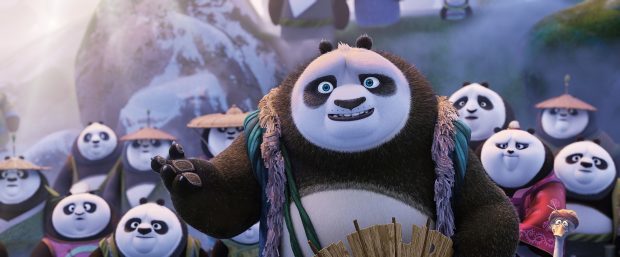Ardent fans of unlikely kung fu-fighting warrior Po will happily grin and panda bear this derivative yet breathlessly energetic third instalment of the computer-animated adventure series.
Visually, Jennifer Yuh Nelson and Alessandro Carloni’s picture is a black belt: bright colours saturate the screen, the 3D format is employed adroitly in gymnastic fight sequences and character detail has improved noticeably since Kung Fu Panda 2.
However, screenwriters Jonathan Aibel and Glenn Berger don’t flying kick and punch the plot into touch with similar urgency or invention.
Mothballed jokes about a panda’s vast appetite or the creature’s inability to scale flights of stairs are aired again and spiky banter between Jack Black’s self-doubting hero and Dustin Hoffman’s despairing red panda mentor also feel like hand-me-downs.
“If you only do what you can do, you will never do more than you can do now,” cryptically sermonises the sensei.
Black’s whirlwind vocal performance, which enlivened the first two chapters, is more of a stiff breeze here, but still whips up big laughs.
His gleefully frenetic verbal riffs are epitomised by one snappy exchange about the chief villain’s propensity to engage in pointless “chitty chat chat” before a fight.
After 500 years of incarceration in the Spirit Realm, megalomaniacal yak Kai (voiced by J.K. Simmons) steals the chi of every kung fu master, including his one-time friend Oogway (Randall Duk Kim).
Only the Dragon Warrior – overweight dumpling-obsessed panda Po (Black) – can bring Kai’s reign of terror to an end.
So the power-crazed yak returns to the mortal plane and gallops towards the Jade Palace to lock horns with Master Shifu (Hoffman) and his plucky disciples: Tigress (Angelina Jolie), Monkey (Jackie Chan), Mantis (Seth Rogen), Viper (Lucy Liu) and Crane (David Cross).
Meanwhile, Po is reunited with his rotund biological father, Li Shan (Bryan Cranston), and embarks on a quest of self-discovery to harness the power of chi.
In a mountaintop panda village, Po builds bridges between Li Shan and his surrogate father, Mr Ping (James Hong), fends off amorous advances from ribbon dancer Mei Mei (Kate Hudson) and learns about his late mother.
“She was the total package: smart, beautiful, tremendous appetite,” gushes Li Shan.
Po also marshals his fellow-bears into a well-drilled army capable of repelling Kai and liberating the creatures under the yak’s Machiavellian control.
Kung Fu Panda 3 is a jaunty affair that breeds comfort and warm smiles through familiarity.
Black’s nervy wisecracking contrasts nicely with Simmons’s bombastic antagonist, while Hong scene-steals mercilessly as the goose who raised the golden panda.
Violence is obscured – no digital creatures were harmed in the making of Nelson and Carloni’s film – and pacing rarely slackens.
The third outing is a fitting conclusion to the series, so DreamWorks Animations will hopefully learn from the mistakes of Shrek and let Po bow out in style.
